In the latest episode of Flux podcast I sit down with Matthew Cauble the co-founder of Kin Euphorics, a functional beverage company that aims to reduce stress and boost bliss. Matthew was previously the co-founder of YC-backed startup Soylent. He shares tales from the company’s early days and describes how they made one of the largest pivots in YC history, from building software-defined radios to meal-replacement shakes.
Matthew explains why Soylent resonated and we get into co-founder Rob Rhinehart’s latest interest in space settlement and the Mars industry event he hosted in the Mojave. Matthew shares why he became interested in wellness, how he’s applying lessons learned at Soylent to building the Kin product, and why he believes that strong companies often look like new social movements. We get into the beverage’s formula that includes nootropics and adaptogens, and what it means to challenge a ritual as ancient as alcohol.
An excerpt of our conversation is published below. Full transcript on Medium.
ALG: Matt is the co-founder and president of Kin Euphorics, a New York based company. Welcome.
MC: Thank you. It’s great to be here.
ALG: So I actually don’t know a ton about your background before what you’re doing now. You were one of the founders and COO of Soylent is that right?
MC: That’s right.
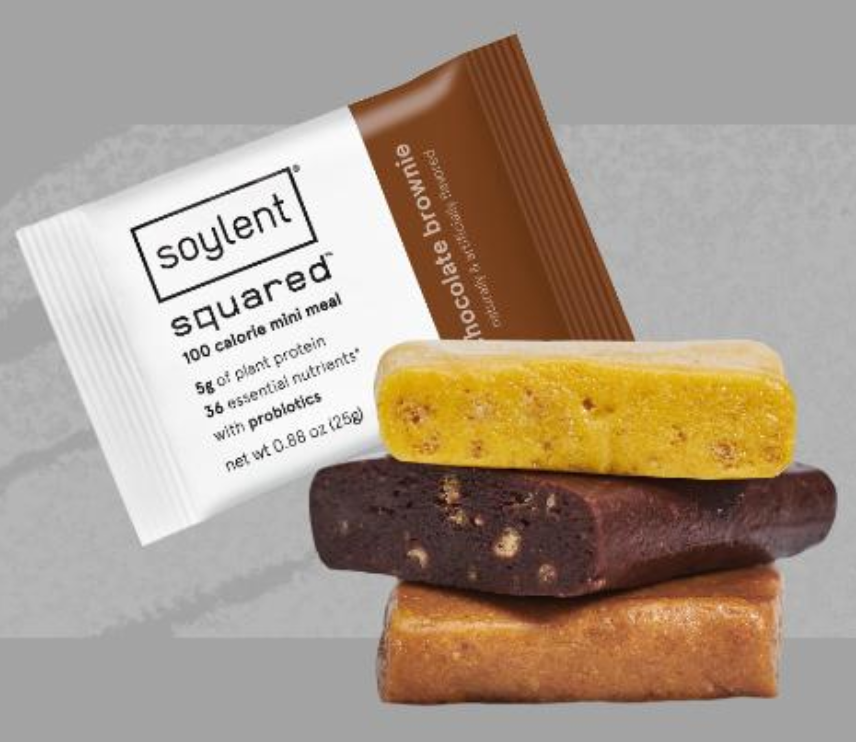
ALG: I don’t know how much our listeners know about Soylent. Let’s presume not too much. There was a couple of articles when Soylent came out that said things like, “This is The End of Food” [the New Yorker] or called it “a contrarian food replacement company.” And it’s been a huge success, selling drinkable meals to initially time-crunched Silicon Valley workers. Now the market’s much bigger. You moved from liquids to solids. A lot of the buyers and consumers of it initially thought about maximizing efficiency as one of the reasons they go for the product. I’ve checked the numbers and there’s a strong community — about 35,000 active Reddit folks in the Soylent community which is amazing. And it’s now a nationwide product. It’s available not only on the e-commerce channels where you started, but also in retail locations like 7-Eleven and Walmart.
MC: It’s in Walmart. That’s the best thing.
ALG: That’s crazy.
MC: The dream.
ALG: And it didn’t start as a food or supplement company. You guys started as cell phone towers?
MC: Wireless networks.
ALG: That seems like a large pivot and interesting journey for the company.
MC: Paul Graham said it was the biggest pivot in YC history. So when Rob and I were in college he was working on building these software defined radios —
ALG: You met in college.
MC: We met freshman year of college.
ALG: Where did you go?
MC: We went to Georgia Tech. Rob is from Atlanta. I’m actually from Arizona. But my grandfather and my uncle went to Georgia Tech. I knew I wanted to leave the West Coast and that I wanted to go somewhere else. And Georgia Tech is an amazing school for what I was studying.
ALG: Incredible technical school.
MC: It’s great. Yeah. I wanted to develop an engineering skill set. I wanted to meet people that were working in technology. I didn’t want to be in a major city but I wanted to be somewhere that felt like a city. Georgia Tech is in downtown Atlanta. It’s absolutely beautiful. Rob and I met freshman year. We were in the same fraternity. If you’ve ever met Rob, he’s one of the most fun people who has some of the best ideas of what to do late at night.
ALG: What was the first time you met Rob do you remember?

MC: The first image I have of Rob is him wearing pants that didn’t quite touch his ankles. But he had extreme confidence. Rob’s a pretty tall guy and he was just coming out of high school.
ALG: So not intentionally cropped pants.
MC: No not at all. I don’t think any of us were expecting to wear pants that day and it happened to be just a day where we had to dress up and so everyone threw something together. But Rob just has this great presence and confidence and he’s a witty, smart person. I love that about him. So we got along from day one and had a lot of adventures throughout college. When we got to the end we realized we wanted to start companies and take risks out of school. Seeing that we didn’t really need any money and didn’t have much responsibility and we had this dream of building something that changed the world. That’s when we got into Y Combinator and moved out to California to work on these wireless networks using software defined radios.
ALG: How did you decide to build wireless networks, what was the conversation?
MC: Rob was thinking about it. He was taking a network class. He was taking a social entrepreneurship class. I took that same social entrepreneurship class. We were thinking about what was something we could bring to the rest of the world. Not just serving customers in the United States, but places in Africa or South America. Developing nations that are getting wealthy. The Internet is the thing. Everyone wants internet. Rob wanted to build a network that people could use in Africa and in rural areas. We also saw an opportunity to build the next AT&T using next wave technology.
ALG: I mean when you look at the NPS for the existing providers, the AT&Ts, they’re pretty low scores. There’s room there. But it does require quite a lot of CAPEX.
MC: Insane CAPEX. The idea was using wireless we could get around a lot of that CAPEX. There was development in the TV networks coming offline opening up this huge amount of space for us to send information across the airwaves that used to be used for ABC and NBC back in the day, which could now be used for people to get internet. And instead of having to set up these like hard network infrastructure we could set up radios and antennas across different houses and apartments and businesses.
ALG: So Paul Graham loved the idea and said come to YC?
MC: I think they were surprised at how audacious these 22 year olds were with this idea. When we went into the interview, typically YC is fast talking, high pressure. But they were laid back and just stricken by this concept of building a software defined radio to make a wireless network. They wanted it to happen. They invested in us because they just thought it was the craziest idea they’d heard.
ALG: So this was when? Summer of?
MC: 2012. We started in Y Combinator May of 2012. We were living down in Silicon Valley. We had this old rundown house. The pool turned into an algae pool. One of our roommates studied bio at Harvard and we would joke about how this algae should be used for something, that we should turn it into something. But what could we possibly do with it. And while we were working 24 hours a day on this network and studying —
ALG: Like, could we use it to power the software defined radio in some way?
MC: Yeah haha. Could we turn this into energy? Could we maybe just encode information in the algae and send it out to people? It actually turned around pretty quickly to talking about bio and synthetic biology and food. Because one of our roommates Dave ended up being a co-founder of Soylent.
ALG: Got it. So it was accidental that you were living in this house together?
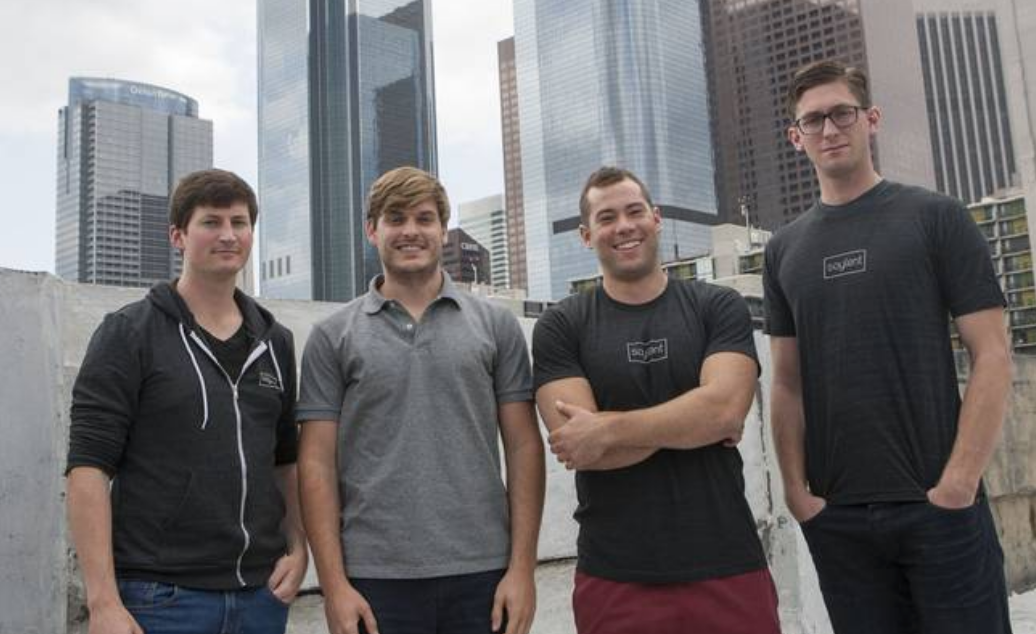
MC: It was. So John and Dave the other two co-founders of Soylent showed up one day. They were in another incubator and just needed a cheap place to live. They walked in and they took a look at the place. I told them the price and they said, when can we move in? I said right now. They said great, all of our stuff is outside in the car. And they moved in that day. We all got along because we just had that attitude of, let’s get this done, keep moving, make decisions and keep pushing forward. We loved talking about our projects, the projects that we thought were interesting, as well as just hanging out. We were good friends. We’re really friends.
ALG: At what point did you decide to move over to Soylent, which I guess is a reference to the novel by Harry Harrison?
MC: Harry Harrison. Yeah. Which is “Make Room Make Room” and the ominous food company in there is called Soylent. They make a bunch of different products and one of them is Soylent Green, which in the book is just meant to be the most efficient food source. It was sensationalized in the movie with Charlton Heston to be made from people. Almost every food company talks about how “people are the key ingredient.” So Soylent was very on the nose about it, food companies are all about people and Soylent just went for it.

ALG: Kind of a wink reference.
MC: Big wink yeah. We just brought it to the top. So we got to Soylent by dropping the wireless network project, moving to San Francisco, and opening ourselves up to any new idea possible. We were humbled by that point. But fortunate to have some money left over from the initial Y Combinator investment. We spent the time developing whatever we could and getting it out there. And Rob started looking at food. He read a book about food and nutrition and biochemistry. He started experimenting. He formed this whole plan to spend a month eating only these raw nutrients in a slurry.
ALG: So it was partly for yourselves that you decided to build the product?
MC: It was for Rob. Rob built this product.
ALG: I’ve got this image of you guys sitting in your house in San Francisco making mulch.
MC: Well house is a loose term, we’re talking about a one bedroom apartment.
ALG: OK. And I guess it was a lot of iterating, self-testing, queasy stomachs? I talk a lot about frontier markets and early adopters on the podcast. How did you make that jump to thinking people are going to want to buy this?
MC: In the summer during Y Combinator, we had this fun discussion about R. Kelly’s “Trapped in the Closet.” Do you know what “Trapped in the Closet” is?
ALG: No.
MC: It’s this hip hop opera. One of the most interesting, wild things that’s probably ever been released. We listened to the first five episodes, laughed about it and saw that there was a way to describe graph theory through “Trapped in the Closet.” Because it’s about all these different relationships people are having and then cheating on each other basically. So Rob created this graph theory explanation in a blog post that reached Hacker News. It got about 150 upvotes and garnered him a bunch of followers on his blog, which he continued to develop content for. Then he pushed out a post about Soylent, about his experience on no food and how he had a miracle experience where he had so much more energy, was very active, had a lot of confidence, was able to study and read. All the things that he ever wanted he was getting out of this experiment that he ran. I think he just had a critical audience that understood. It spoke to them. It sounded interesting. It started going viral on Hacker News and Facebook almost immediately. Rob came in a day after he released his blog post, sat down and said, I think people want this product. He knew that because he had 4000 e-mails or something crazy. A ton of emails in his inbox people from all over the country asking him to give them the Soylent.
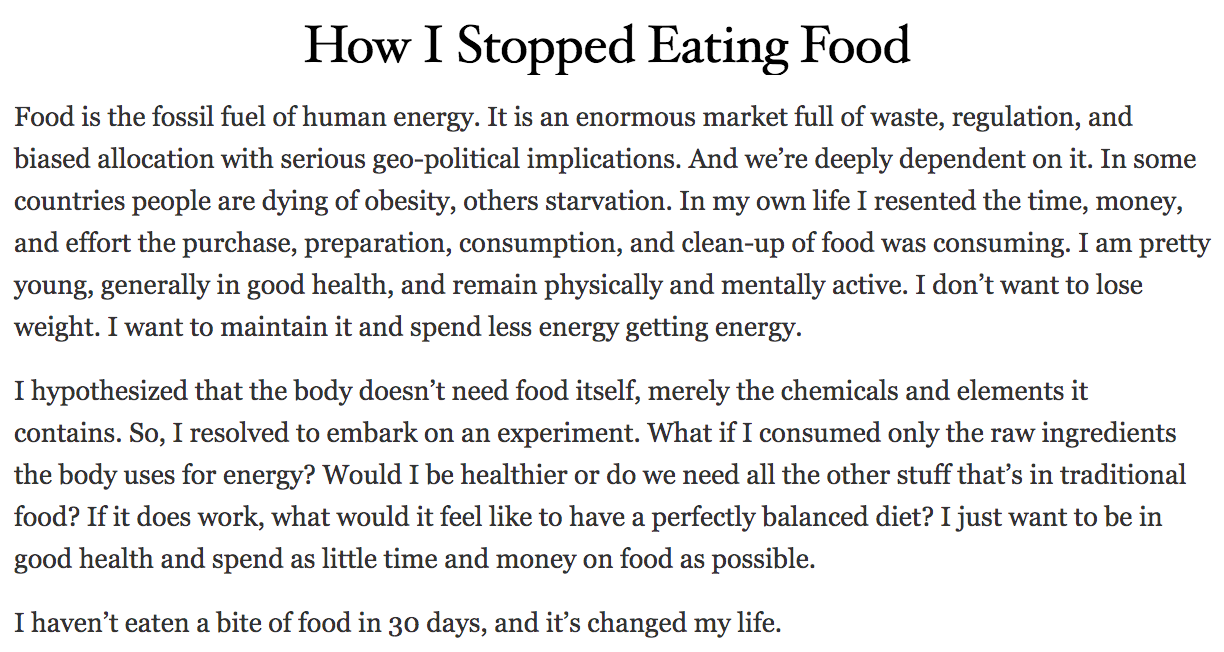
ALG: Why do you think it hadn’t been done before?
MC: I don’t think anyone was bold enough to say they stopped eating food. People think too hard about how do you sell a story to the customer. Rob had this beautiful way of thinking about it — well, this is replacing my food. I was eating food and now I’m not eating food right. Now I’m eating this thing that I’m calling Soylent.
ALG: So it’s pretty simple. We don’t have to sell this in a complicated way. We know people want it. Let’s just make it and sell it.
MC: It’s not even that we know people want it. It’s — I know I want it. I know I had a great experience. I’m going to tell the truth. And truth is one of the best sales things you can possibly have. So Rob just saw. If you read that blog post it’s just dripping with truth and emotion and real experience that people related to. It’s one of those ideas that people are like, I thought about this too. I never want to clean my dishes. I don’t like going to the store. I don’t like having to think about my nutrition. This makes total sense for me.
ALG: So the early adopter there was, I don’t say workaholics, but folks who wanted to focus on other things and minimize the amount of effort or calculation that goes into, where’s my next meal coming from?
MC: That’s right. What we learned is that food, 80 percent of the time is for fuel. It’s for that ability to go to work, to do meetings, to hang out with people in a productive way. Then there are the times that are romantic with your family, with your significant others, sharing stories over fires. Those are great times to have traditional food. But Soylent is the perfect food to have whenever you’re busy.
ALG: I always associated it with going to Mars. Though it might be quite heavy actually come to think of, as its a liquid. But in terms of what are we going to use to fuel ourselves as humans on the way to Mars. I always thought that that was one of the things behind Soylent. I actually saw Rob at this event in LA in the desert run by SynbioBeta. It was called Betaspace. It was 100 founders, folks from NASA, SpaceX who were getting together to discuss colonizing Mars, or industries that could be viable now with revenue that could be generated now that can also be used on Mars. Rob was a big part of sponsoring that —

MC: It was on his land.
ALG: There was a ritual, a ritual around destroying old tech. I guess Rob now is looking a lot at Mars. And you are helping to build this new company here in New York called Kin Euphorics. I’d love you to explain what it is. We also have it here in the studio and I have never tried it.
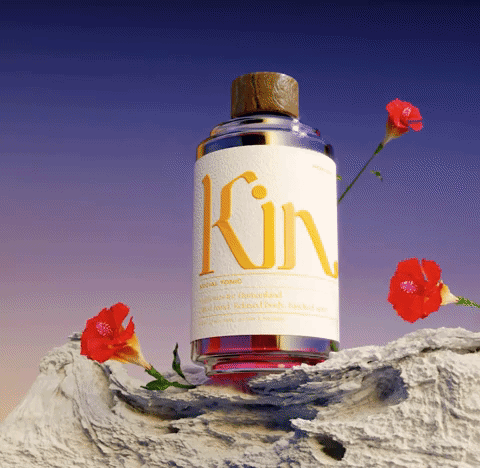
MC: I think we should start off by pouring glasses. Then we can talk about it.
ALG: OK great. Because I wanted to see if over the course of the conversation I might feel some effects.
MC: Yeah. We’ll have a good conversation at least. Let’s go ahead and open it and pour some drinks. Have a proper social conversation. Break the ice.
ALG: I don’t know if this is technically allowed in the studio but —
MC: There’s no booze in it. We don’t need a license or anything for this. We can serve this anywhere we want. Are you gonna try it straight? Let’s try it straight and do some tasting notes.
ALG: So I’m doing a wine sniff, are you supposed to do that.. [sloshes drink] Wow.
MC: What does it remind you of.
ALG: Well I’m from England where we have a lot of herbals and liqueurs. Everything from Ribena, to lime juice, to elderflower cordial. That’s what we drink at home. What does this remind me of? There are some herbal notes. But it’s strong and light at the same time.
MC: That’s right. We made it so you can mix it pretty easily into whatever you want.
ALG: I want to say some licorice or spices?
MC: Yeah there’s licorice in there. You nailed it. It’s inspired by Campari. When I first started thinking about this problem of alcohol and hangovers and social drinking I was in Italy drinking a lot of Campari spritzes.
ALG: I love Campari. Though they do give you a bit of a hangover. I’m drinking this straight now. So I’m going to mix in —
MC: Let’s mix in some tonic water. Which one do you want. Do you want this. Angostura, do you want this one?
ALG: So you got the idea for Kin in Italy?
MC: Well backing up, I left Soylent in 2016 and our accountant introduced me to my co-founder Jen. At the time she was working on a wellness company. We had a great conversation about why are people who are looking for health and wellness still drinking. When you have a wellness event people are still serving wine. One of the easiest things you can do to be healthy is just not drink. But that isn’t exactly true because it’s hard to have any social life if you’re not drinking. It’s very difficult, especially in New York City, to live and meet people and expand your career if you’re not going out to bars and restaurants and drinking at least wine. I thought that was an interesting problem.

And I continued traveling, went around South America went to Europe. My first interest was in curing hangovers. As I started looking into the effects of hangovers and what happens when we process alcohol, I realized it has become a big problem. Like wow this is something that we’re doing and we’re not even thinking about it. It’s a leading cause of cancer, it kills people every year. It’s got all these downsides. But there’s also this beautiful side to it, this ritual, this social connection, this gathering side. When I got back from traveling I started thinking about what I wanted to work on next. I called up Jen and said, hey let’s go ahead and try to make something that takes down alcohol. Or at least replaces alcohol for that social benefit.
ALG: Wow.
MC: We spent about a year working on different formulas. We were looking into, what is it that people actually want when they drink. We came to this realization that people want to feel something and they want to feel it with other people in a ritual.
ALG: But it could be a different feeling than what we currently experience?
MC: Yes. We want to be taken out of our current mode, which I think is stress. We’re typically stressed out right now. We want to feel a little less stressed. We want to think about something other than work. So what are different compounds that people are taking if they have high anxiety, if they’re socially awkward, if they can’t sleep, if they’re lethargic —
ALG: You didn’t just want to dose Xanax into some kind of mixer?
MC: Haha no.
ALG: The whole of New York is on that anyway.
MC: Yes we’re finding out there’s a lot of people with drug interactions. Start making a drink that offers these effects and people will tell you immediately if they’re taking anything else. We’ve found out that a lot of people in York City are medicating.
ALG: I think everyone’s medicating based on the data I’ve seen. I might be the only person I know that’s not on Xanax or one of those. Let’s talk about the ingredients. If you go on the website you talk about how it’s “euphorics for humankind.” Essentially it’s botanical spirits. Based on the compounds you’ve got in here, including adaptogens and nootropics, you say that you’ll experience a “rise” within maybe 15 minutes of drinking. We’re about 10 minutes in. I’m waiting for that rise. I’m generally excited so I might just rise anyway.
MC: I can tell. You have the anticipation. Placebo is gonna be real for you.
ALG: I know. I’m excited. I want it to work. And it says it might last one hour. It’s supposed to “adapt to what our bodies need to balance our hormonal response to stress, which is to reach a homeostasis.” I guess what you’re getting at is cellular balance? What is the rationale behind that?

MC: Euphorics, that word actually means to come into health. It’s a Greek word that means to come into yourself. To come into your true self. Which is homeostasis. That feeling of euphoria is to not only give you that rise and give you that feeling of awake and less stress but also to actually heal you. So the ingredients that we put in there — Rodeola is is the main root in the current formula that has been used in ayurvedic Eastern medicine for a long time in order to balance out stress and cortisol levels. So if your cortisol is too high it’ll bring it down, if it’s too low it actually bring it up. I think most people right now have cortisol levels that are too high as we feel like we’re being attacked all the time. We balance that out with other ingredients like B vitamins that help replenish your neurotransmitters. We put in Citicoline, which increases oxygen flow to your cells. We put in L-tyrosine which is a precursor to dopamine. 5-HTP is a precursor to serotonin. And hibiscus, which has been used in the Middle East for a long time to increase blood flow and lower blood pressure. So before you start drinking booze your brain is firing dopamine in anticipation of that drug. Your body has that relaxing, the shoulders drop, you feel chilled out. What we decided to do with Kin instead was put in the precursors for dopamine. So what you’re feeling instead of just anticipation, you’re actually feeling like a nourishment of dopamine, that increased amount from the drink itself.
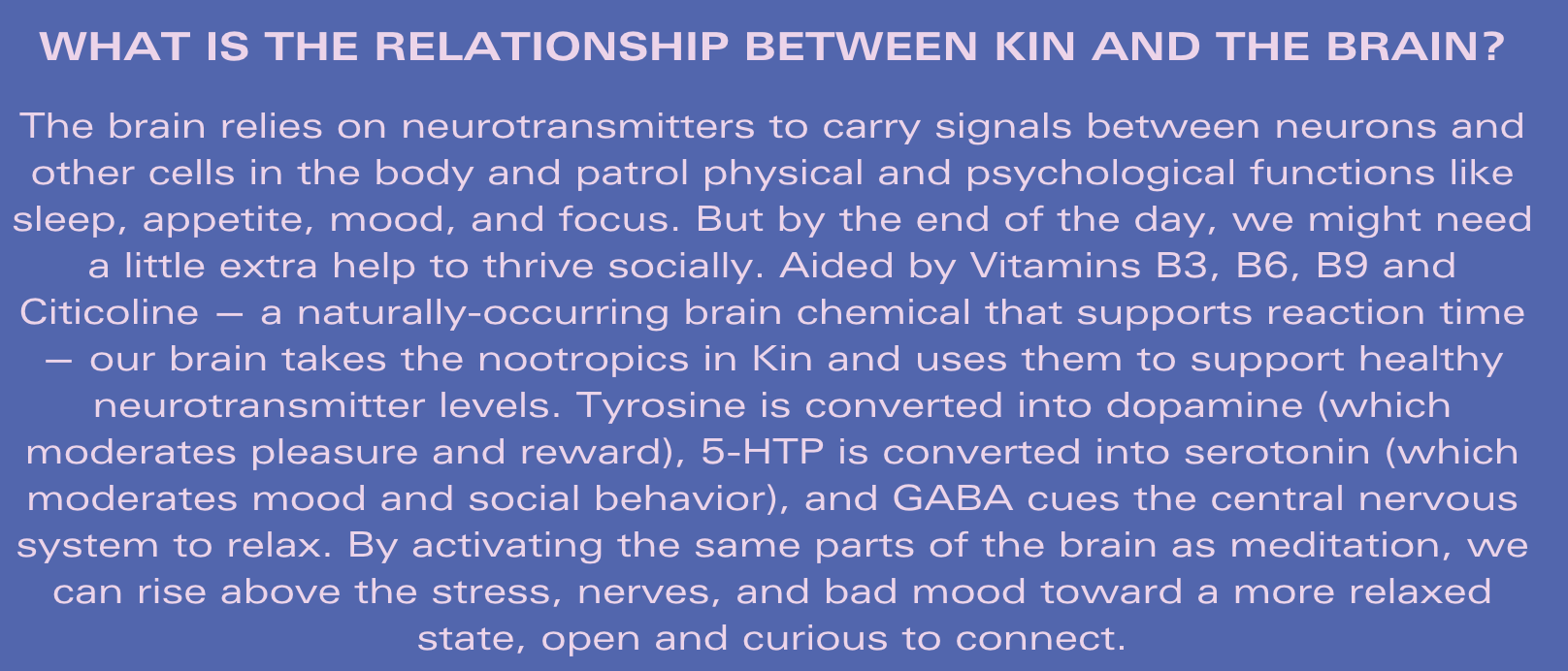
ALG: A lot of this ties to neurochemistry. I messaged my friend who’s a neuroscientist this morning, he loves this stuff. I asked, “what do you think of adaptogens and nootropics?” He said, “well they’re not mainstream scientific terms, they’re more marketing speak. But if these guys do invent the magic brain cocktail I want to start using it immediately.” I feel like that’s the general attitude of people right now. There’s some skepticism that it actually works but everyone wants it to work.
MC: That’s right. If you look at alcohol it can’t make any claims about what it does. If you look at all of its marketing and what it is, it’s purely situational. It’s purely aspirational. We have a similar problem to solve. What we’re trying to get people into is this whole new way of drinking with their friends. And there isn’t a ton of science about nootropics or adaptogens. It’s a lot of anecdotal and a lot of experiential. Fortunately in this age of social media people are willing to talk about it openly. So we have those channels open for people to call us and to talk about their experiences.

ALG: So the wellness industry over the last two years it grew 13 percent. It’s now a four trillion dollar industry of which $700 billion is about eating and nutrition. You’re probably in that booming category. Nootropics is about $1.3 billion now and estimated to be $6 billion by 2024 and that’s not even anything proven. There’s nothing scientific in there. It’s fascinating to watch that market growing. There’s a lot of cultural and social trends driving it regardless of any science underneath it.
MC: People just want to live longer. People want to live longer and be healthy. We’ve seen the effects of being unhealthy on a lot of the population and people in our own families. We’re so educated now. We have ambitions and we want to make things. We want to create. We say that Kin is about uniting creators and if you have a brain you’re a creator. What nootropics and health and wellness is about at the end of day, is not just making yourself feel good. It’s about doing good. Doing things that you want to do. Having the energy and the time to do it. If we can be what your friend called it, “the brain cocktail the future,” if we can be that platform for people to go out at night or throughout the day. Be together and have something that gives that that effect and that feeling and that drives more creation. Then we’re changing humanity. We’re actually pushing people forward.
ALG: It’s exciting. You could change the trajectory. We’ve been drinking alcohol for —
MC: Eight thousand years.

ALG: Quite a long time. There hasn’t been much change to that.
MC: No. It’s crazy to think about how the rise of civilization, the rise of laws, the rise of agriculture — all coincide with this discovery of alcohol. Looking around you can see how it affects behavior. And if behavior is what drives culture, then how much of an impact has alcohol had on who we are today?
ALG: It’s fascinating to think that we’re on the cusp of these alternative ideas that are starting now. You’re obviously in the food and beverage space so you have been thinking about these things for a long time. You probably saw the Beyond Meat IPO recently. They set their IPO at $25 and it’s now at $146 dollars. That’s a 480% gain since the IPO — crazy.
MC: I love Beyond Meat, just on the record. I also love Impossible. We are so fortunate that there is so much money, interest and competition going into this. We win at the end of the day.
ALG: Yes. They’re the first one to IPO and they’re at a market cap of $9 billion that’s about 70% of the market cap of Campbell’s which is $13 billion. And Campbell’s does 100x the revenue of Beyond Meat.
MC: People are excited about the future. It’s like Tesla and cars. These companies that are offering the promise of the future, of how we’re gonna live on Mars. That’s what people want to invest in right now. There’s that pent up optimism for how we can change ourselves. Beyond is a great example of that.
ALG: What’s fascinating is that both times — with Soylent and now with with Kin — you identified early adopter groups. What do you see as the similarities, what have you learned from speaking to a passionate, engaged, forward-thinking initial consumer?
MC: With Soylent Rob was the perfect fit for the initial market, which was people living in San Francisco. People in tech. Rob is a software engineer. He knows how to speak the language of software and he applied that language to food. That got people that typically thought about bits and bytes to think about their calories and proteins. Rob did a great job of hitting that initial market. We were able to start there and grow out. And now it’s in Walmart. It’s all over the country and people know what Soylent is for the most part.
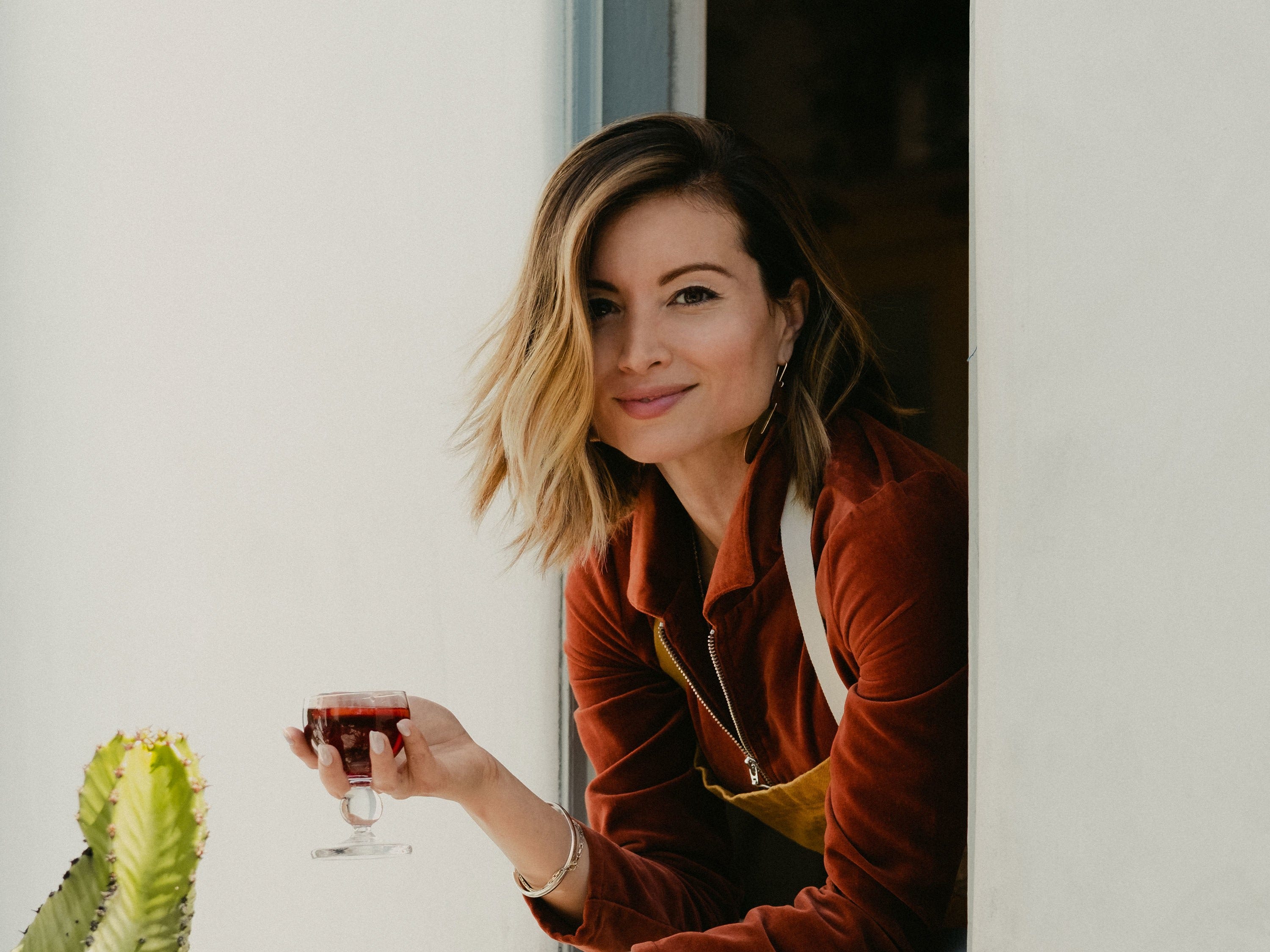
With Kin, actually my co-founder and I realized that the initial market would be women in urban cities, that are in the workforce, building their careers, starting their own businesses, creating their own channels. My co-founder is the perfect face and CEO for this company, because she speaks to them so well. She comes from wellness. She comes from helping people heal. She’s also a fun, lively person. So we realized early on that the market was going to be this group of women that she is a part of. When thinking about new markets I don’t think I’m the person that can lead them. I’m humble and I look for the the person that’s the right person to lead the group, to start a movement. At the end of the day a great company looks a lot like a social movement. It looks a lot like a MLK or Gandhi. Companies are like new social movements that you should be looking for.
ALG: You’re starting a religion.
MC: You could say that.
ALG: Interesting that most of your followers are women so far.
MC: Yes we’re about 70 percent women, split between New York and Los Angeles, which is who we’ve been focused on. People looking for that new alternative. When we talk to our customers they say, “I’ve been looking for this for years and I have never had this option. I’m just so grateful.” You want to hear customer feedback of gratefulness to the point where you cry. We got that at Soylent. We’re getting that now with Kin. At the end of the day that’s what makes you wake up in the morning. A real person telling you how much love you’re giving them. That’s what everyone should be trying to do right.
ALG: How do you feel about building this company in New York. Why New York?
MC: New York is the most social place on earth. People are out and about all the time.
ALG: So if you could crack the alcohol industry here, the nightlife and social customs and get togethers, then you could crack it anywhere?
MC: Yeah. The saying is if you can make it here you can make it anywhere. I think socially that’s very true. New York is the perfect place. There’s a ton of fashion. A ton of creators. Tons of art in New York City across a lot of different industries. If Kin can be the main drink for people in these creative industries in New York City it’s just going to spread to other places.
ALG: Is there a presumption that the LA wellness folks are going to adopt this super fast anyway?
MC: I haven’t even thought about LA wellness people. They have so many options out there. LA has so many options.
ALG: It’s interesting that you don’t have CBD in it.
MC: We tried. We actually tried to put CBD in. It just doesn’t make sense. No one’s figured out what CBD is yet. No one has actually said this is what it does for you.
ALG: There’s no neurochemistry in it.
MC: No. It seems to be some sort of anti-inflammatory on the level of an Ibuprofen. There are benefits to that but it’s not nearly the benefits that people are talking about so far. That being said I think people have had real experiences on CBD and that’s great for them too.